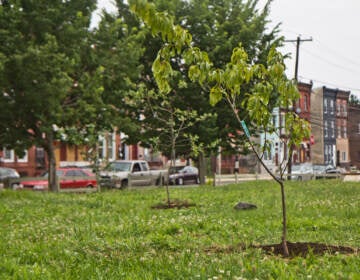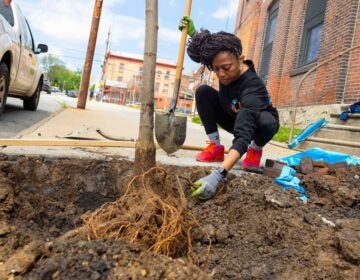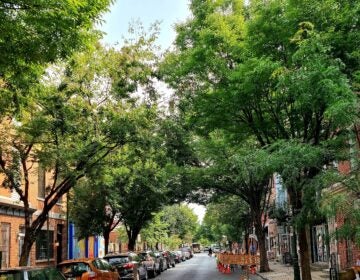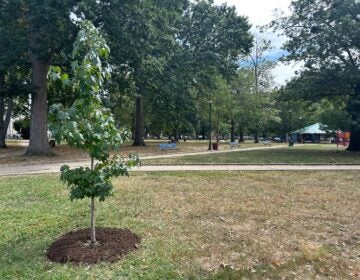Philly moves ahead with draft plan to increase the city’s green canopy
The Philly Tree Plan aims to nearly eliminate the difference in temperature between the hottest Philadelphia neighborhoods and the citywide average.
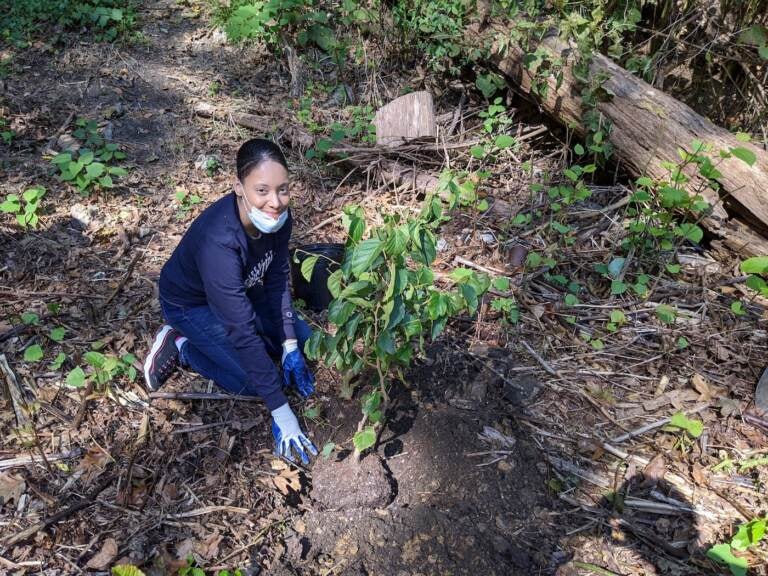
Gabriella Gabriel Paez plants a tree. (Courtesy of Gabriella Gabriel Paez)
The plan that aims to nearly eliminate the difference in temperature between the hottest Philadelphia neighborhoods and the citywide average on a sweltering summer day is almost done.
The Philly Tree Plan aims to reduce the canopy disparities between Philly neighborhoods that contribute to temperature gaps of up to 22 degrees Fahrenheit. Trees not only help keep neighborhoods cool, they store planet-warming carbon and have been associated with better health outcomes for nearby residents, including reducing respiratory symptoms.
“Heat feels more abusive whenever you don’t have adequate shade,” said Kiasha Huling, director of the University City-based environmental organization UC Green.
Recently, the city’s tree cover has gone in the wrong direction. The city lost 6% of its canopy between 2008 and 2018, largely in residential areas.
As of 2018, 20% of the city was covered by trees. City officials want to increase that to 30% within 30 years, and the draft Philly Tree Plan sets more specific goals, including prioritizing areas with higher levels of poverty, poorer air quality, poorer mental and respiratory health, and more exposure to heat.
The plan will guide city activities over the next ten years, but its benefits could be felt much further into the future — since it can take 30 years for a new tree to grow to its full canopy size, according to city staff drafting the plan.
The plan, several years in the making, comes from months of intense public engagement and input from thousands of residents. City officials published draft recommendations in early November and accepted public comment until midnight Wednesday, through an online survey.
Making it easier to take care of your tree
The huge differences in tree coverage between Philly neighborhoods — like a tree canopy of just 3% in parts of South Philly compared to over 80% near Wissahickon or Pennypack parks — closely correlate with neighborhood income, a 2019 PlanPhilly analysis found. At the time, the poorest half of city residents lived in census tracts that accounted for just one-third of all city street trees. Poorer residents also have less access to air conditioning and other ways of avoiding the potential deadly summer heat.
The city’s street tree program, which is request-based and won’t plant without a property owner’s permission, has not helped close the disparities in tree coverage. Wealthier property owners tend to participate more often. A historic lack of engagement with low-income communities means many residents don’t know about the program. The city’s TreePhilly program, which gives out about 2,000 free yard trees per year, tries to target low-canopy areas by working with trusted community groups.
“Previously, I think the notion was that places that don’t have trees have people who don’t want trees, and that’s not the case,” said Huling. “Through outreach and through engagement, folks do want trees.”
But trees can be a liability or financial burden, Huling said, because property owners are currently responsible for non-emergency maintenance of street trees and the cost of any sidewalk repairs. This contributes to the canopy gap between wealthy and less affluent areas, Huling said, as those with more resources and political capital can demand tree-related resources from the city and can afford to hire a private tree service to prune trees or remove old stumps.
“The squeaky wheel gets the oil,” Huling said.
But the Tree Plan aims to change this, by reducing the burden that street trees place on residents.
In the short term, the draft plan recommends cost-sharing programs between the city and property owners for tree-related maintenance and repairs. In the long term, the city would take full responsibility for sidewalks in the public right of way — a significant new investment. The draft plan also recommends increasing the city’s urban forestry staff so they can proactively inspect and maintain all street and park trees on a regular schedule. It suggests a city call center for questions, concerns and requests about trees.
Some cities do not require approval from the property owner when planting a street tree. The City of Philadelphia can legally plant trees in the right of way without property owner approval, but planting trees without explicit approval creates confusion and distrust between residents and the city, said Maita Soukup, a spokesperson for the Department of Parks & Recreation.
City officials had said at the start of the planning process that the Tree Plan could recommend getting rid of the rule that a property owner must sign off on a tree planting in Philly — but the draft plan does not recommend this.
“We’re trying to focus more on making it easier for people to participate in the tree planting programs with support through many other types of programs,” said Erica Smith Fichman, community forestry manager at Philadelphia Parks & Recreation, which spearheaded the plan.
Huling, who organizes tree plantings and shares tree care information with residents as a Tree Tender through the Pennsylvania Horticultural Society, said Philly’s owner approval requirement is a “barrier” to increasing canopy cover in the city, in part because it makes it hard for renters to request trees. She said it “would have been nice” if the plan suggested an alternate system, but city officials didn’t go that route.
Holding developers accountable for killing trees
The Tree Plan could help prevent the loss of trees through development, by strengthening requirements on developers.
Sarah Anton, beautification chair of the Passyunk Square Civic Association and co-chair of PHS’ Tree Tenders Committee, said developers are slow to plant trees around new buildings in her neighborhood. She said there seems to be “no teeth” to enforcement by the city.
“Trees sometimes end up being the last thing that get talked about,” she said.
Huling has also seen developers cut down trees to make way for construction equipment, then fail to adequately replace them.
“I’m thinking of Brewerytown, Cobbs Creek, some of the River Wards, where tree removal is going hand-in-hand with some pretty aggressive development,” Huling said. “Canopy loss is happening at lightning speed.”
The draft plan recommends the city increase the number of trees developers are required to plant and institute fees and fines for not meeting these. These fines and fees would then be put into a tree fund, which would go toward zoning code review, enforcement of new tree policies and investments in communities.
The only trees currently protected during development are specific species on a “heritage trees” list, with trunks larger than two feet wide, according to city officials. The plan recommends developers create a protection plan for all trees on site, and recommends community approval for removal of all non-invasive tree species with a trunk more than two feet wide.
“I think if those can be kind of enforced, that is a wonderful start,” Anton said.
The plan recommends creating a new Office of the City Forester, which exists in other cities, to oversee tree-related regulations and coordinate tree programs and planning.
“That would have to be a shared relationship between [Parks and Recreation] and L&I, perhaps, but a position where we have someone higher up who is giving their expertise sooner in the process and holding developers accountable to the zoning code,” Smith Fichman said.
Outreach to continue
One neighborhood with low tree cover and brutal summer temperatures is Hunting Park, where community organizer Gabriella Gabriel Paez has spent years planting trees and training other tree advocates in both English and Spanish. Gabriel Paez said the unequal distribution of greenery and heat in the city is largely due to redlining and disinvestment.
“The solution to this is for us not to just plant trees everywhere just because we want to plant everywhere,” she said. “We need to look at what are the areas that need trees the most.”
Gabriel Paez, a member of PHS’s Tree Tender Community Advisory Committee who helped advise the city on the Philly Tree Plan, said the document does this by prioritizing sections of North, South and Southwest Philadelphia where residents experience high rates of health problems linked to poor air quality and a dearth of trees. “So these areas can then catch up and also become hopefully as healthy as other communities that have plenty of shade,” she said.
The path to more tree cover will not look the same in every neighborhood, Huling said. Some have sidewalks that are too narrow for street trees, and in others, residents may prefer trees in mini parks rather than near their homes.
“Engagement going forward absolutely looks like an ongoing conversation with community and the stewardship of a community-led vision for greening,” she said.
The process to create the plan itself involved extensive outreach. City officials presented it at 32 community meetings, collected 7,000 survey responses in eight languages, and paid 22 community ambassadors to interview their friends and neighbors about trees.
‘We will change it’
The draft recommendations are not set in stone.
“If we see that a recommendation is not in line with what people want to see and we get feedback about that, then we will change it,” Smith Fichman said.
The city received nearly 1,000 survey responses as of Tuesday afternoon, Smith Fichman said, which officials will analyze over the month of December. The final report is expected in early 2022.
___
Editor’s note: This story has been updated to reflect that the window for public comment has closed.

Subscribe to PlanPhilly
WHYY is your source for fact-based, in-depth journalism and information. As a nonprofit organization, we rely on financial support from readers like you. Please give today.




